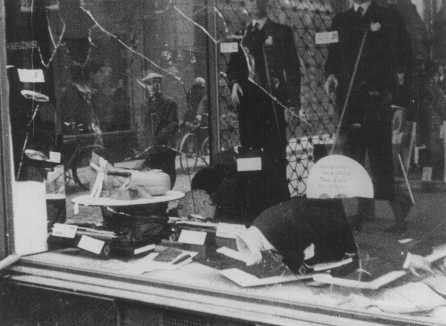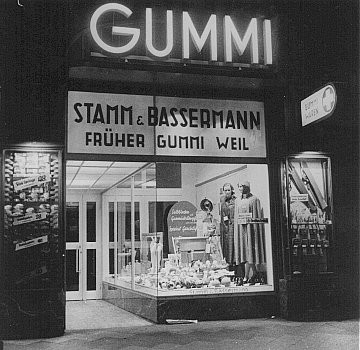
"Aryanization"
“Aryanization” (in German, Arisierung) refers to the transfer of Jewish-owned property to non-Jews in Nazi Germany from 1933 to 1945. It aimed to transfer Jewish-owned economic enterprises to “Aryan,” that is, non-Jewish ownership.
There were two distinct phases of “Aryanization”:
- From 1933 until summer 1938: “voluntary Aryanization”
- From fall 1938 until the collapse of the Nazi regime in 1945: “forced Aryanization”
"Voluntary Aryanization"
Under “voluntary Aryanization,” the Nazi German state encouraged Jewish businessmen, who were already facing economic and social discrimination, to sell their businesses in Germany at radically reduced prices.

In early 1933, there were about 100,000 Jewish-owned businesses in Germany. About half of these were small retail stores dealing mostly in clothing or footwear. The rest were factories or workshops of various sizes or professional offices for lawyers, physicians, and other independent professionals.
By 1938, the combination of Nazi terror, propaganda, boycott, and legislation was so effective that some two thirds of these Jewish-owned enterprises were out of business or sold to non-Jews. Jewish owners, often desperate to emigrate or to sell a failing business, accepted a selling price that was only 20 or 30 percent of the actual value of each business.
"Forced Aryanization"

Immediately following the violent nationwide anti-Jewish riot on November 9–10, 1938 (Kristallnacht), “Aryanization” entered its second phase: the forced transfer of all Jewish-owned businesses to non-Jews.
In the aftermath of Kristallnacht, the Nazi German state issued new regulations that prohibited Jews from undertaking most economic activities in the country. The regime assigned every remaining Jewish-owned enterprise a non-Jewish trustee to oversee its immediate forced sale to non-Jews. The trustee’s fee for this required service was often only slightly less than the sale price and it was paid by the former Jewish owners. Some of the profits from the sale also went to the Office of the Four Year Plan, headed by Hermann Göring, which was preparing the German economy for war.
The funds needed to start large scale armament production were raised in part through the confiscation of property and valuables from the Jewish population. German Jews who wished to emigrate were forced to forfeit much of their property. The Reich government charged an exorbitant “Flight tax” on Jews leaving Germany.
Further, after Kristallnacht, Göring imposed a one billion Reichsmark (RM) fine on the Jewish population in Germany. The fine was a direct personal tax on every Jewish taxpayer who had assets over 5,000 RM. The state also confiscated all the insurance payments that should have been paid to Jewish property owners, who were then made responsible for property repairs after the pogrom. After payment of these fines and extra taxes, any remaining funds were paid into blocked accounts at German banks. The Nazi German state strictly supervised these accounts. The owners could draw only a fixed monthly sum, the minimum required for their living expenses.
During the war, the Nazi German state seized the remaining monies in these blocked accounts. Personal effects, property, and other assets from Jews who were deported to eastern Europe as part of the “Final Solution” were confiscated and usually auctioned or simply distributed to bombing victims who had lost property during the Allied bombing of German cities.
Impact
No precise figures are available for the total value of property taken from Jews in Germany under the Nazis. But it is clear that Jews who emigrated from Germany were able to take only a small fraction of their property with them. Those who were deported during the war lost everything; most also lost their lives.
Critical Thinking Questions
How does this program demonstrate the complexity and the systematic nature of the German efforts to persecute the Jews?
What governmental organizations and bureaucracies participated in and implemented this program of mass theft? What pressures and motivations affected decisions by managers and employees?
How did the German public respond to this legal assault on the Jewish community?
What recourse do minorities have when governments take resources and limit opportunities?

